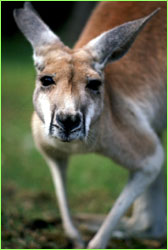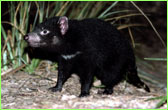 |
 |
Why Do Islands Breed Giants (And Sometimes Dwarfs)?
Part 2 | back to Part 1
Blazing the trail
The trail that Foster and Case began cutting decades ago has been further
cleared by a growing band of biogeographers. These workers, too, have come up
with generalizations, and they, too, grant exceptions. Like any scientists in a
nascent field, they still vociferously argue the particulars, but they agree on
some general conclusions.
Large size, for one, appears to confer a number of selective advantages. Jumbo
creatures can exploit a wider range of resources (larger predators, for
example, can feed on big as well as small prey). Because of that ability, they
can give birth to larger litters or clutches. Heftier individuals tend to
dominate others of their kind in territorial skirmishes and other conflicts
over resources. And because they have greater stores of energy and water, they
can better survive famine and drought.
Small size, too, has its advantages. Bantam animals need fewer resources to
survive and reproduce. That's important on islands, where resources are more
limited than on continents. They are more efficient at absorbing nutriment and
energy. They can hide from predators in smaller refugia. And they can better
cope with stressful environmental conditions.
| 
 "Time dwarfing" took place in various Australian marsupials,
including the red kangaroo and the Tasmanian devil.
"Time dwarfing" took place in various Australian marsupials,
including the red kangaroo and the Tasmanian devil.
|
Researchers have made other discoveries in their pursuit of answers as to why
islands breed giants and dwarfs. For one, size changes can occur with
astonishing speed. In a mere 6,000 years after it found itself isolated on
Jersey, a Channel Island 15 miles off the coast of France, the red deer dwarfed
to one-sixth its size on continental Europe. The Wrangel Island mammoths went
from six tons to two tons in just 5,000 years. Another finding: Species tend to
increase in dimension with island area and isolation. Still another: In insular
mammal species, there is a certain body size above which they tend to wane and
below which they're apt to wax. That size is just under nine ounces, about the
weight of a red squirrel. (Median size of mammals diminishes with land area;
thus, in Madagascar, it is a tad over eight ounces, in Australia 7.6 ounces,
and in North America, just under three ounces.)
Human beings, as they're wont to do, can throw a wrench into the works. While
studying evolutionary trends in Australian mammals, Tim Flannery, a research
scientist at the Australian Museum, identified something he calls "time
dwarfing." Humans are thought to have first colonized the island-continent
40,000 to 60,000 years ago, and Flannery reported that over the past 40,000
years, body sizes of most Australian marsupials has decreased. He hypothesizes
that aboriginal people, out to maximize their harvest of meat, probably hunted
larger species, and larger individuals within those species. Over time, this
would have diminished the fitness of relatively large individuals, Flannery
posits, causing dwarfing in surviving species.
Nagging questions
Despite all the work in the three and a half decades since Foster first took an
intellectual machete to the tangle of questions surrounding the
gigantism/dwarfism question, much awaits illumination. As biologists James
Brown and Mark Lomolino conclude in their classic textbook Biogeography,
"the generality of the island rule and its corollaries ... remain promising
areas for future studies."
 The Komodo dragon—a classic case of gigantism run amok?
Perhaps not.
The Komodo dragon—a classic case of gigantism run amok?
Perhaps not.
|
|
Such studies might clear up some nagging evolutionary conundrums. No one knows,
for instance, whether the Seychelles giant tortoise became humungous before or
after it arrived in the archipelago. No one knows why insular bears show only a
slight degree of dwarfism despite their bearish build and carnivorous habits.
And no one knows why ducks tend toward dwarfism. Many birds in evolutionary
history have become gigantic (and flightless)—the great auk, the ostrich,
the elephant birds of Madagascar. Why has evolution never produced a giant
flightless duck? "A question," muses Quammen, "to lie awake over."
One of the most intriguing enigmas concerns the Komodo dragon. By all
appearances, this voracious monitor lizard represents an archetypal case of
gigantism. Thought to have grown huge on a diet of now-extinct pygmy elephants—whose fossil bones have turned up on Flores, one of the Indonesian islands
where the dragon lives—the species today can grow up to ten feet long and
weigh 330 pounds; it can drag down and devour deer, water buffalo, and people.
Yet while it is the world's largest lizard, a much heftier monitor lived in
Australia during the Pleistocene—a 23-foot-long, 1,370-pound monster. Could
it be that the Komodo dragon, the most fiercesome lizard on Earth, is actually
an insular dwarf? Biogeographers: Break out that machete.
Peter Tyson is editor in chief of NOVA Online.
Photos: (4-8) Corbis Images.
Seychelles Through Time |
Saving the Magpie Robin
Why Do Islands Breed Giants? |
Build an Island
Resources |
Transcript |
Site Map |
Garden of Eden Home
Editor's Picks |
Previous Sites |
Join Us/E-mail |
TV/Web Schedule
About NOVA |
Teachers |
Site Map |
Shop |
Jobs |
Search |
To print
PBS Online |
NOVA Online |
WGBH
© | Updated November 2000
|
|
|